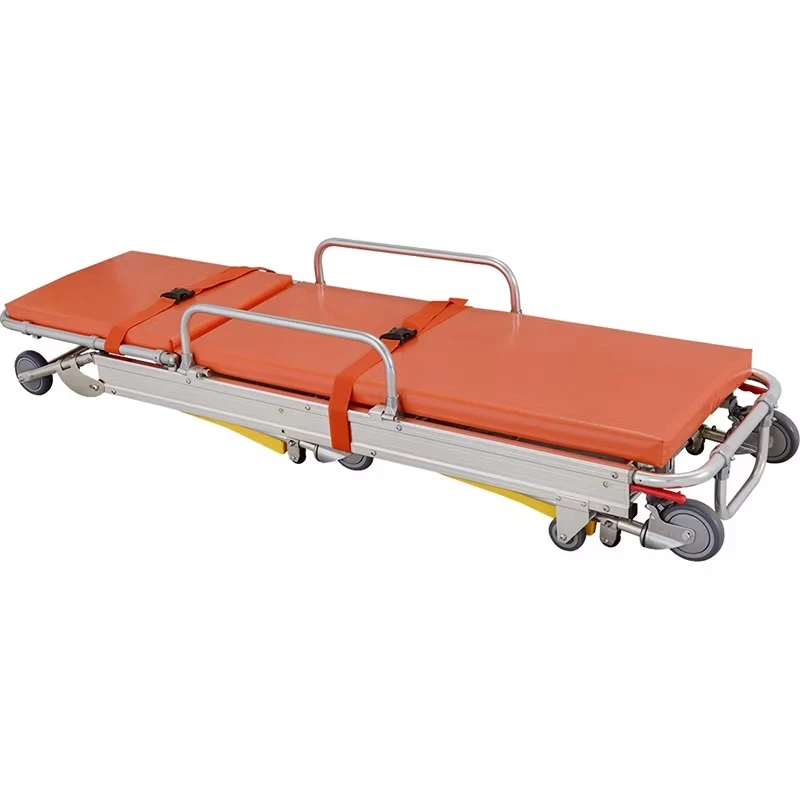Hospital Stretcher Trolley | Lightweight, Safe, Durable
Field Notes on a Modern Hospital Stretcher Trolley: What Buyers Should Really Know
I’ve spent enough mornings in ambulance bays to know this much: stretchers don’t just carry patients; they carry moments where seconds matter. That’s why the Medical equipment transfer stretcher from Zhouhu Village, Jizhou Zone, Hengshui City, Hebei Province, China, caught my eye. It’s a pragmatic Hospital Stretcher Trolley designed for the gritty reality of EMS and ER corridors—no fluff, just details that matter. And yes, there’s more nuance here than the spec sheet lets on.

Industry trends (and what ops teams quietly ask for)
Globally, procurement teams want three things: lighter frames, safer transfers, and fewer service calls. We’re seeing a steady shift to aluminum alloy frames (for weight and corrosion resistance), multi-height ambulance loading, and better patient ergonomics. This unit leans into that: aluminum alloy structure, a sponge (foam) cushion, a backrest that actually adjusts to a humane angle, and three height settings to match common ambulance decks. The rubber outer wheels—simple, reliable—are appreciated in tight ward corridors.
Key specifications (real-world, not brochure fantasy)
| Frame material | Aluminum alloy structure (anodized finish, ≈606x series typical; real-world use may vary) |
| Backrest adjustment | Manual, around 0–65° for comfort during transport |
| Height positions | Three adjustable heights for ambulance loading |
| Wheels/tires | Rubber outer wheels; low-noise, floor-friendly rotation |
| Mattress | Sponge cushion (removable cover, wipe-down cleaning) |
| Safe working load | ≈180–220 kg (verify per lot test report) |
| Net weight | Around 32–38 kg (configuration-dependent) |

Where it’s used (and why crews like it)
- Ambulance and EMS transfer—three-step height makes loading less of a wrestling match.
- ER triage and imaging shuttles—rubber wheels glide quietly; fewer hallway scuffs.
- Disaster relief, surge wards—light, durable, and frankly forgiving in rough setups.
Many users say the adjustable backrest is underrated; a slight incline reduces anxiety and improves breathing for some patients. It’s small, but it’s humane.
Manufacturing and quality flow (short version)
Materials: aluminum alloy extrusions, steel fasteners, medical-grade sponge cushion, rubber wheel treads.
Methods: cutting, CNC drilling, TIG/MIG welding, surface treatment (anodizing), assembly, functional check.
Testing: static load test ≈1.5× rated load; roll/fatigue cycles ≥10,000; brake/locking checks; salt-spray on coated parts (e.g., ASTM B117 guidance); cushion wipe-resistance and seam pull tests.
Service life: commonly 5–8 years under normal hospital use (with routine maintenance).
Standards buyers often request: ISO 13485 QMS, EN 1865-1 for stretchers, EN 1789 for ambulance compatibility, ISO 14971 risk management. Certifications vary by batch and market—request the current dossier.

Vendor comparison (my notebook version)
| Vendor | Pros | Watch-outs |
|---|---|---|
| Zhaofa (Hebei, China) | Competitive pricing; aluminum build; three-height ambulance loading; customization available. | Documentation depth may vary—ask for recent EN 1865-1 test reports. |
| EU Tier-1 Brand | Comprehensive certifications; robust after-sales; higher load ratings ≈250 kg. | Price premium; longer lead times during surges. |
| Budget Importer | Lowest initial cost; quick availability. | Inconsistent QC; sparse manuals; spares hard to source. |
Customization options
- Colors, logos, and mattress fabrics (fluid-resistant covers).
- Wheel diameters and brake styles; IV pole, belts, side rails.
- Documentation pack: risk files, IFU translations, third-party test summaries.
Mini case studies (two quick snapshots)
City EMS: Swapped legacy steel units for this Hospital Stretcher Trolley. Crews reported easier ambulance loading and fewer corridor scuffs in the first quarter, plus a small but real drop in strain-related complaints.
Private clinic network: Adopted the system for imaging transfers. They liked the quiet rubber wheels and asked for custom mattress covers for frequent disinfection—supply chain handled it smoothly.
What to verify before you buy
- Latest test data: static/dynamic load, brake holding on slopes, backrest locking.
- Compatibility with your ambulance deck height and loading system.
- Spare parts list and response time for service calls.
- Certificates: ISO 13485 (manufacturer), EN 1865-1 alignment, and relevant risk files.
To be honest, the best gear is the one your team trusts at 3 a.m. This Hospital Stretcher Trolley aims squarely at that trust-without-drama niche.
Authoritative citations
- ISO 13485:2016 Medical devices—Quality management systems. https://www.iso.org/standard/59752.html
- EN 1865-1:2010+A1:2015 Patient handling equipment used in road ambulances—Part 1: General stretcher requirements. https://standards.cen.eu
- EN 1789:2020 Medical vehicles and their equipment—Road ambulances. https://standards.cen.eu
- ISO 14971:2019 Medical devices—Application of risk management. https://www.iso.org/standard/72704.html
- ASTM B117: Standard Practice for Operating Salt Spray (Fog) Apparatus. https://www.astm.org/b0117-19.html




































